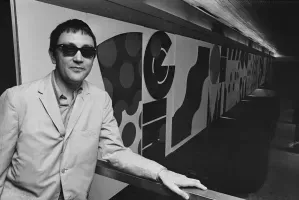Джо Тилсон (1928–2023)

Прорывной британский поп-художник Джо Тилсон, однажды подросток-плотник, который знаменитость получил за свои яркие деревянные рельефы и конструкции, а также за свои яркие печати повторяющихся мотивов, умер дома в Лондоне 9 ноября в возрасте девяносто пяти лет. Исследуя сначала коммерцию, затем политическую активность и социальные изменения, а затем философию и до-классическую мифологию, в течение семидесяти лет своей карьеры Тилсон постоянно отказывался от статизма в пользу создания произведений, которые различались по влиянию, материалам и внешнему виду. Он избегал концепции художника как бренда и отстаивал важность непосредственного опыта зрителей восприятия искусства. «На то, что художники говорят о своей работе, я бы не обращал никакого внимания», - сказал он газете "theArt Newspaper" ранее в этом году. «Смысл внутри вас». Джо Тилсон родился 24 августа 1928 года от бедных родителей, которые были телеграфистами.
Выросший на юге Лондона, он проявил интерес к искусству в возрасте восьми лет, когда выиграл местное соревнование на дизайн дорожного знака безопасности. Отец отговорил его от преследования страсти, и в тринадцать лет он поступил в Брикстонскую школу строительства, в пятнадцать лет устроился работать на фабрику, где делал столы. В 1946 году, в возрасте восемнадцати лет, он был призван в ВВС, где служил три года. По окончании службы, вооруженный грантом для "дальнейшего образования и подготовки" и крупной суммой, он поступил в Школу искусств Сент-Мартин в Лондоне, где познакомился с современниками, включая Фрэнка Ауэрбаха и Леона Коссоффа. В 1952 году он поступил в Королевский колледж искусств, где подружился с Питером Блейком и Дэвидом Хокни. По окончании в 1955 году ему была присуждена престижная Римская премия, и он отправился в итальянскую столицу, чтобы рисовать.
Во время пребывания там он познакомился со своей будущей женой, тогдашней Джослин Мортон, с которой он жил на Сицилии и...в Венеции, прежде чем вернуться в Лондон в 1958 году. В том же году он начал преподавать в своей старой школе, Святого Мартина; он также преподавал в Школе изящных искусств Слейда в Лондоне и в Школе визуальных искусств в Нью-Йорке. В начале 1960-х годов Тилсон активно экспериментировал с материалами, такими как цемент, мешковина и дерево. В 1962 году он провел свою первую персональную выставку в галерее Марлборо в Лондоне. В 1964 году его пригласили выставиться в Британском павильоне на Тридцать Второй Венецианской биеннале, известной как Биеннале поп-арта, которая включала Джима Дайна, Джаспера Джонса, Клэса Ольденбурга, Роберта Раушенберга, а также Тилсона и других. Выросший в несколько мрачной обстановке, он был вдохновлен ярким обещанием американской рекламы с ее резкими цветами, яркими логотипами и бурной чувствительностью.
Его работы того времени отражали это в полной мере, как в рельефной работе "Geometry? 7" 1964 года, где слово-заголовок написано в очень стилизованном шрифте, так и в радужной пирамиде "Zikkurat 9" 1967 года. Характерно для работ такого рода было увлечение головоломками и обеспокоенностью, разделяемой британскими поп-художниками, такими как Блейк и Ричард Гамильтон, вопросом о нарушении иерархии между оригиналом и копией. "Период поп-арта, который изначально назывался новым образом или предметным живописью, возник из веры того времени, предваряющего Вьетнам, что все, что связано с Америкой, хорошо - Голливуд, фильмы, приветствие новых вещей", - рассказал Тилсон в интервью "RA Magazine" в 2013 году. "Но в 1967-68 годах я радикально изменил свое направление из-за войны". Тилсон начал создавать работы, откликающиеся на контркультурную политику, к которой он и его жена тогда глубоко привлекались. Главными из них были его серия работ "Страницы 1969 года", которая включала группу работ, характеризующихся трехмерной деревянной решеткой, которая отражала структуру радикальных газет того времени, в каждую из которых был вставлен одеянный печатью на ткани статьи или изображение, многие из которых были взяты или отсылались к таким изданиям.
В 1972 году он переехал с семьей в бывшую ректорию в Уилтшире.р, где он использовал натуральные материалы, такие как веревка, камень и солома, и создавал работы, многие из которых включали повторяющиеся символы или слова, выжженные или выжженные в дерево, посвященные темам, таким как четыре элемента - воздух, ветер, вода и огонь, или аборигенное представление о "времени сновидений". В начале 2000-х Тильсон и его жена вернулись в Лондон, живя в викторианском домике для рабочих недалеко от слоанского сквера, хотя, как и в течение десятилетий, они продолжали поддерживать дом и студию в Тоскане, а также студию в Венеции. В этом году Тильсон наслаждался ретроспективами как в галерее Марлборо, так и в галерее Кристи Робертс в Лондоне. Кроме того, издательство Лунд Хамфрис выпустило монографию о его работе. Тильсон был назван членом Королевской Академии в 1991 году, а также Старшим Академиком в 2003 году, на следующий год после большой ретроспективы его творчества, представленной Королевской Академией. Его работы находятся в коллекциях крупных учреждений по всему миру, включая Центр искусства Уокер, Миннеаполис; Музей современного искусства, Нью-Йорк; Йельский центр британского искусства, Хейвен; Художественная галерея Уокер, Ливерпуль; Тейт и Виктория и Альберт музеи, оба в Лондоне; Стеделейк Музей Амстердам; Фонд Калусте Гюльбенкян, Лиссабон; и Галерия Национального искусства Модерна, Рим..